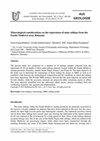Bond Yield Spreads in the Eurozone
Q4 Mathematics
Analele Stiintifice Ale Universitatii Al I Cuza Din Iasi - Matematica
Pub Date : 2015-07-01
DOI:10.1515/aicue-2015-0015
引用次数: 1
Abstract
Abstract Euro Area sovereign bond yield spreads fell significantly after the creation of the monetary union and moved in unison until the recession of 2008, when investors’ risk pricing changed considerably. Rising bond yield spreads caught the attention of economists who tried to find the factors influencing their size. Evolution of bond spreads was mostly related to various macroeconomic factors as well as the soundness of the countries’ banking sectors and a general level of risk aversion in the financial markets. Analysis presented in this paper compares bond yield spreads of Euro Area member countries and relates them to their debt levels as well as the liquidity of the securities and a general level of risk aversion. Apart from the usual variables, we also analysed differences in purchasing power to assess the impact of the common monetary policy in the pre-crisis period. After adjusting the model to better explain movements of linear regression residuals, we could not prove a systematic assessment of the above-mentioned factors except for time periods of high market volatility. We explain sudden changes in the importance of idiosyncratic factors as consequences of policies of the European Central Bank and other European Union institutions following such time periods, which, as our analysis suggests, distorted pricing of risk in the markets.欧元区债券收益率息差
欧元区主权债券收益率差在货币联盟成立后大幅下降,直到2008年经济衰退,投资者的风险定价发生了很大变化。不断扩大的债券收益率差引起了经济学家的注意,他们试图找出影响其规模的因素。债券息差的演变主要与各种宏观经济因素以及各国银行部门的健全性和金融市场普遍的风险厌恶程度有关。本文的分析比较了欧元区成员国的债券收益率差,并将其与债务水平、证券流动性和一般风险厌恶水平联系起来。除了常用的变量外,我们还分析了购买力的差异,以评估危机前共同货币政策的影响。在调整模型以更好地解释线性回归残差的运动后,除了市场波动较大的时间段外,我们无法证明对上述因素的系统评估。我们将特殊因素重要性的突然变化解释为欧洲央行和其他欧盟机构在这段时间内的政策后果,正如我们的分析所表明的那样,这些政策扭曲了市场上的风险定价。
本文章由计算机程序翻译,如有差异,请以英文原文为准。
求助全文
约1分钟内获得全文
求助全文
来源期刊
CiteScore
0.70
自引率
0.00%
发文量
2
审稿时长
>12 weeks
期刊介绍:
This journal is devoted to the publication of original papers of moderate length addressed to a broad mathematical audience. It publishes results of original research and research-expository papers in all fields of mathematics.

 求助内容:
求助内容: 应助结果提醒方式:
应助结果提醒方式:


